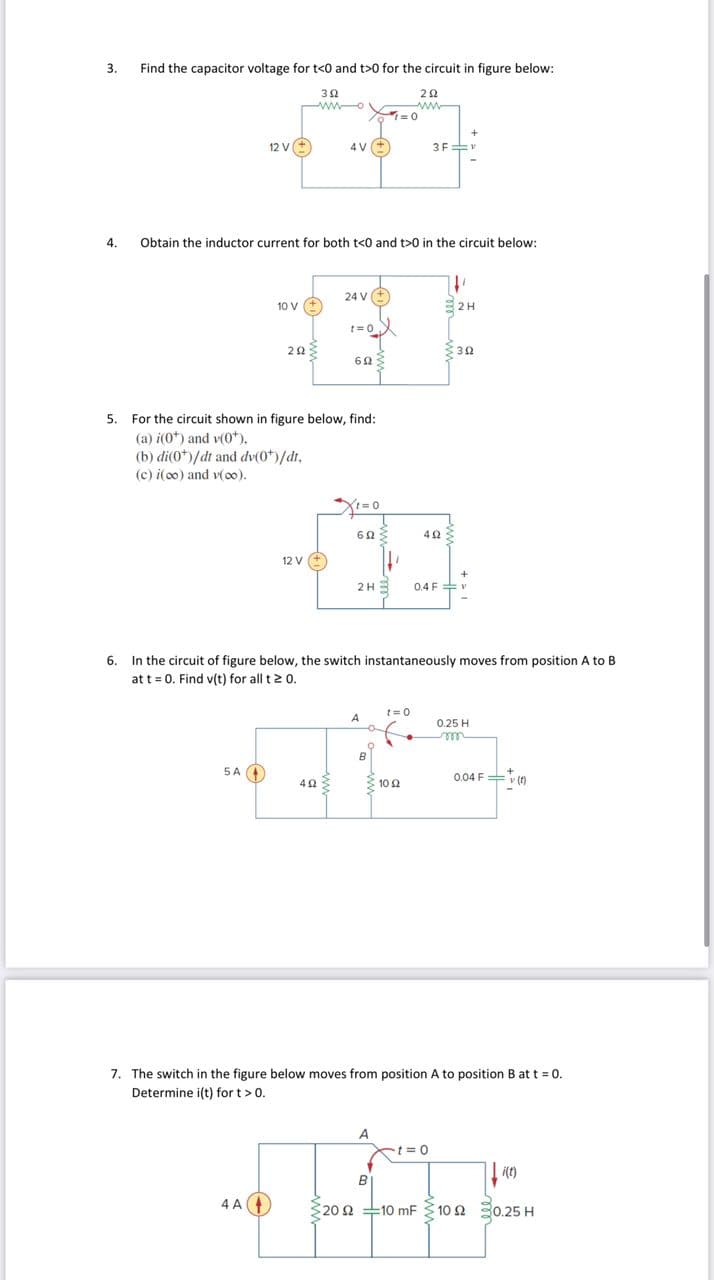3. Find the capacitor voltage for t<0 and t>0 for the circuit in figure below: 302 292 12 V 10 V 4. Obtain the inductor current for both t<0 and t>0 in the circuit below: 5A 2023 (b) di(0*)/dt and dv(0*)/dt. (c) i(00) and v(00). 1+ 12 V 4V 5. For the circuit shown in figure below, find: (a) i(0*) and v(0*). 24 V 402 1=0 602 Xt=0 6 Ω 2H 1=0 www A 3F 1=0 6. In the circuit of figure below, the switch instantaneously moves from position A to B at t = 0. Find v(t) for all t 2 0. 1052 492 0.4 F 2H 302 0.25 H 0.04 F
3. Find the capacitor voltage for t<0 and t>0 for the circuit in figure below: 302 292 12 V 10 V 4. Obtain the inductor current for both t<0 and t>0 in the circuit below: 5A 2023 (b) di(0*)/dt and dv(0*)/dt. (c) i(00) and v(00). 1+ 12 V 4V 5. For the circuit shown in figure below, find: (a) i(0*) and v(0*). 24 V 402 1=0 602 Xt=0 6 Ω 2H 1=0 www A 3F 1=0 6. In the circuit of figure below, the switch instantaneously moves from position A to B at t = 0. Find v(t) for all t 2 0. 1052 492 0.4 F 2H 302 0.25 H 0.04 F
Introductory Circuit Analysis (13th Edition)
13th Edition
ISBN:9780133923605
Author:Robert L. Boylestad
Publisher:Robert L. Boylestad
Chapter1: Introduction
Section: Chapter Questions
Problem 1P: Visit your local library (at school or home) and describe the extent to which it provides literature...
Related questions
Question
do question 5

Transcribed Image Text:3.
4.
Find the capacitor voltage for t<0 and t>0 for the circuit in figure below:
3902
12 V (+
5 A
10 V +
Obtain the inductor current for both t<0 and t>0 in the circuit below:
ΖΩΣ
4A4
4V (+)
12 V (+)
5. For the circuit shown in figure below, find:
(a) i(0*) and v(0*).
(b) di(0*)/dt and dv(0*)/dt,
(c) i(oo) and v(00).
24 V +
4922
t=0
6023
Xt=0
6023
2H
A
1=0
O
222
www
t=0
+
3F V
6. In the circuit of figure below, the switch instantaneously moves from position A to B
at t = 0. Find v(t) for all t≥ 0.
3 10 92
4ΩΣ
0.4 F
"
2H
392
0.25 H
m
0.04 F(0)
7. The switch in the figure below moves from position A to position B at t = 0.
Determine i(t) for t > 0.
A
-t=0
B
+F
20 2 -10 mF 10 2 30.25 H
Ω
:
i(t)
Expert Solution
This question has been solved!
Explore an expertly crafted, step-by-step solution for a thorough understanding of key concepts.
This is a popular solution!
Trending now
This is a popular solution!
Step by step
Solved in 4 steps with 3 images

Recommended textbooks for you

Introductory Circuit Analysis (13th Edition)
Electrical Engineering
ISBN:
9780133923605
Author:
Robert L. Boylestad
Publisher:
PEARSON

Delmar's Standard Textbook Of Electricity
Electrical Engineering
ISBN:
9781337900348
Author:
Stephen L. Herman
Publisher:
Cengage Learning

Programmable Logic Controllers
Electrical Engineering
ISBN:
9780073373843
Author:
Frank D. Petruzella
Publisher:
McGraw-Hill Education

Introductory Circuit Analysis (13th Edition)
Electrical Engineering
ISBN:
9780133923605
Author:
Robert L. Boylestad
Publisher:
PEARSON

Delmar's Standard Textbook Of Electricity
Electrical Engineering
ISBN:
9781337900348
Author:
Stephen L. Herman
Publisher:
Cengage Learning

Programmable Logic Controllers
Electrical Engineering
ISBN:
9780073373843
Author:
Frank D. Petruzella
Publisher:
McGraw-Hill Education

Fundamentals of Electric Circuits
Electrical Engineering
ISBN:
9780078028229
Author:
Charles K Alexander, Matthew Sadiku
Publisher:
McGraw-Hill Education

Electric Circuits. (11th Edition)
Electrical Engineering
ISBN:
9780134746968
Author:
James W. Nilsson, Susan Riedel
Publisher:
PEARSON

Engineering Electromagnetics
Electrical Engineering
ISBN:
9780078028151
Author:
Hayt, William H. (william Hart), Jr, BUCK, John A.
Publisher:
Mcgraw-hill Education,